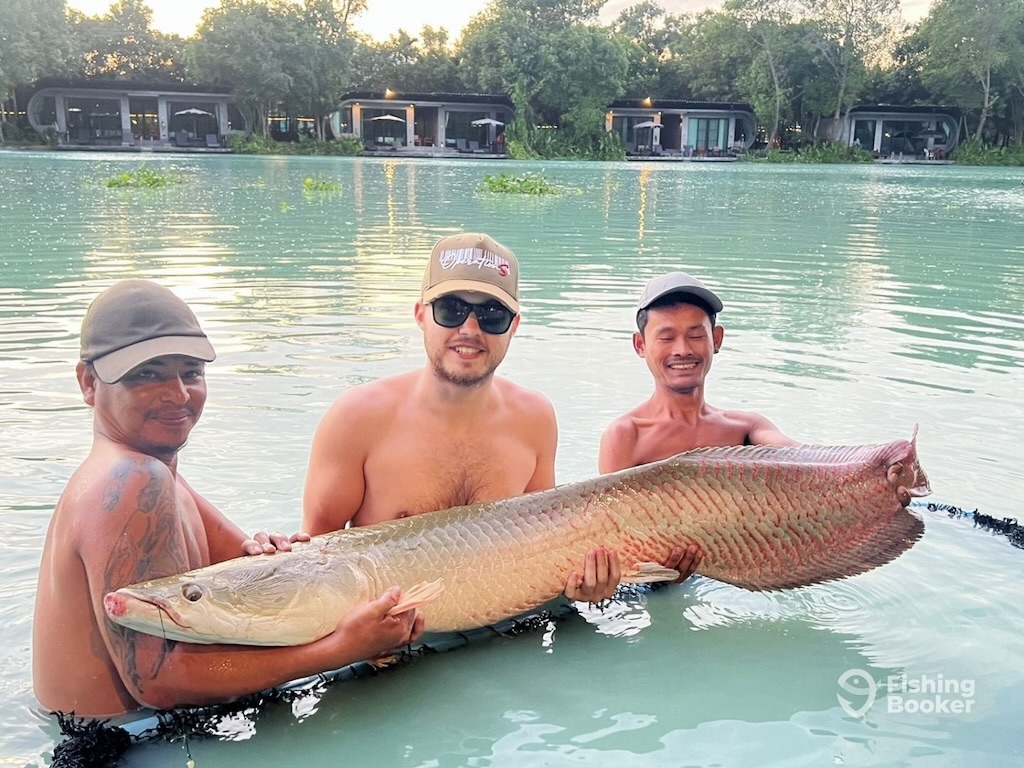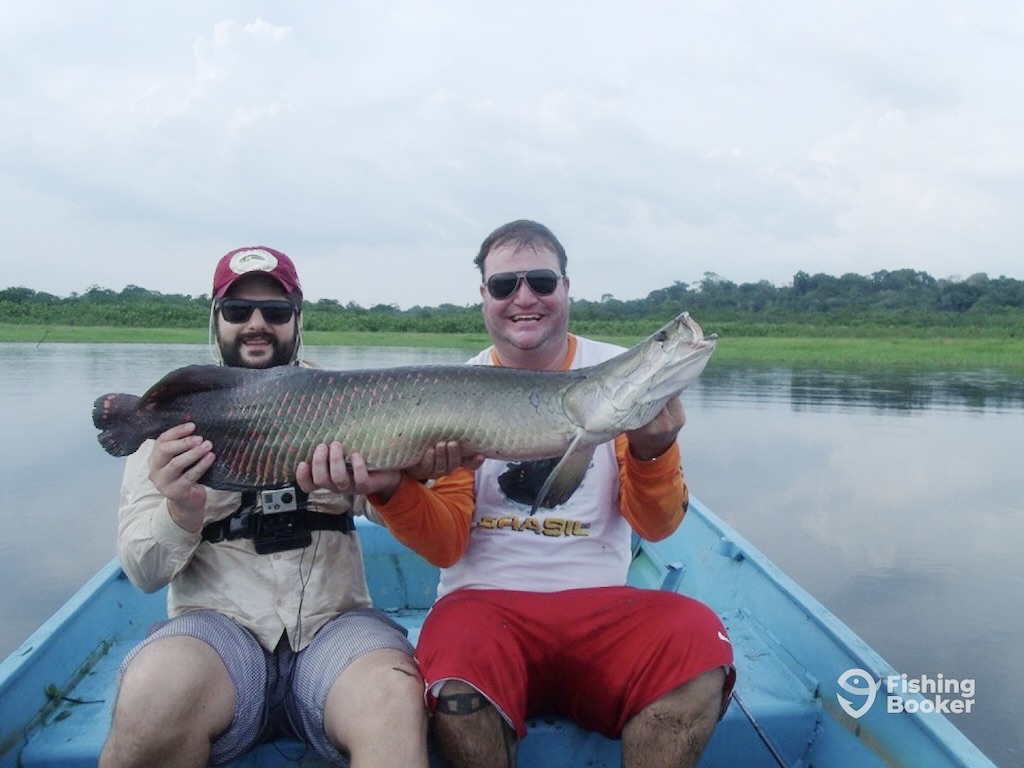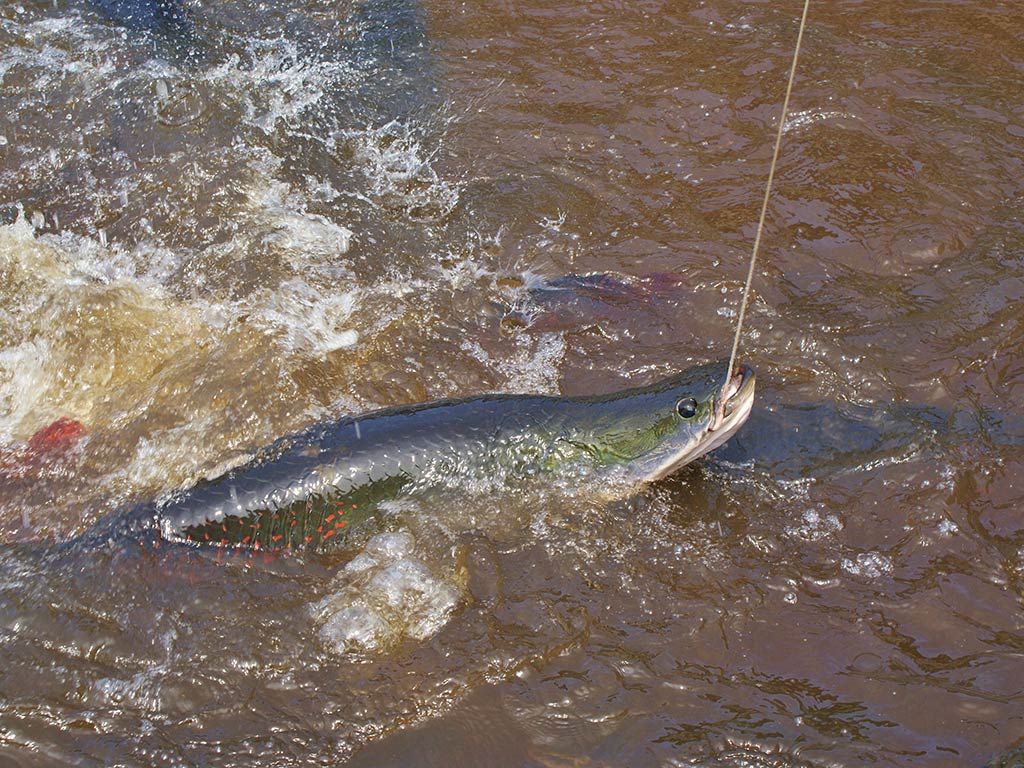When it comes to our wildest fishing fantasies, few species compare to Arapaima. Native to the sprawling waterways of the Amazon Basin, these prehistoric predators are some of the largest freshwater fish on Earth. Tracking them down in the jungle is an adventure in and of itself, only to be followed by explosive surface strikes as you tangle with a beast your own size (and possibly twice your weight). It almost sounds like a scene out of Indiana Jones – which, really, isn’t so far-fetched. After all, Arapaima fishing is the stuff of legends…
How to Identify Arapaima

There are several closely related species in the Arapaima genus, but Arapaima gigas is the most iconic. However, if you’re fishing in Brazil or Peru, you’ll need to know the names Pirarucu as well as Paiche, respectively.
Native to the Amazon Basin, Arapaima are legendary throughout South America. While their reputation stretches far and wide, there are only a handful of places where you can catch them in their natural habitat. That being said, they’ve been introduced in ponds across the world, with Thailand’s world-famous man-made lakes holding plenty.
These fish dwell in slow-moving rivers, lakes, and flooded forests of the Amazon. Unlike most fish, they’re able to thrive in warm, oxygen-poor water because they actually breathe air. Watching these dinosaurs surface every few minutes is a breathtaking spectacle in and of itself, which only adds to the excitement for anglers stalking them.
When it comes to looks, Arapaima are unmistakable. Their long, canoe-shaped bodies resemble species like Snakehead, Gar, and Saratoga. Meanwhile, their dark, massive scales will remind you that these fish are dinosaurs. The fiery color radiating from their tails is especially striking and only burns brighter as they age.
And that’s not to mention the size of these beasts. Wild Arapaima typically stretch 6–8 feet long and weigh 200–300 pounds. It won’t be easy, but catching one of this caliber isn’t out of the question. That’s why so many anglers travel the globe in pursuit of these fish, after all!
Best Arapaima Fishing Spots
Tracking down Arapaima means braving some of the most remote and exotic fishing grounds in the world. The majority of these are waiting for you in South America, but you can also fish for Arapaima further afield…
Brazil

Brazil’s Amazon River system is the birthplace of Arapaima and remains one of the best places to catch them. Vast river networks, flooded forests, and remote lagoons are the perfect lair for these water dragons. Manaus, the gateway to the Amazon, is where many fishing expeditions begin.
The prime fishing season here runs during the dry season (July – December), when water levels are lower and Arapaima are easier to locate. In many regions of Brazil, catch-and-release is mandatory to protect wild populations.
Peru
The Pacaya-Samiria National Reserve in northern Peru boasts some of the largest Arapaima in South America. What’s more, the water here is probably the most pristine you’ll ever see. So pristine, that these glassy waterways have earned the nickname “Jungle of Mirrors.” Now, if that doesn’t sound like the perfect title for your angling adventure, we don’t know what is!
Peru’s Arapaima fishing season is similar to Brazil’s, when water levels run lower between June and November. Again, strict regulations require that all Arapaima be released and many guides operate under eco-tourism models.
Colombia

Fishing in Colombia offers a slightly less-traveled route compared to Brazil and Peru, making it ideal for anglers who are extra adventurous. For a chance to wrangle your very own Arapaima, head to the Amazonian region around Leticia and the Yahuarcaca Lakes.
The best months for Arapaima fishing in Colombia are typically from July through October. As in neighboring countries, catch-and-release is the standard, and fishing should be done with local licensed guides.
Guyana
Slightly less known is Guyana’s Essequibo River, which offers outstanding Arapaima fishing along with its tributaries. Conservation efforts here have been highly successful, with sustainable practices ensuring a healthy Arapaima population.
Prime Arapaima season in Guyana runs from September to February. Again, pairing up with a local guide and releasing your catch will ensure you do your part to maintain this fishery.
Thailand

If you can’t see yourself cutting through the dense jungles of South America, Thailand offers a more accessible fishing experience. It’s likely you’ll have to fly farther to get here, but once you do, the Arapaima will be eating out of your hand – quite literally! These fish and many other exotic species have been introduced to the country’s fishing parks, where they thrive in controlled environments.
Fishing for Arapaima in Thailand is a year-round opportunity, though the cooler months (November–February) are often more comfortable for anglers. Since many Arapaima here live in private lakes, you can expect a more controlled experience, but also some incredibly large fish thanks to active management of the fisheries.
How to Fish for Arapaima
Arapaima fishing is a mix of strategy, patience, and strength. Despite their size and raw power, these fish spook easily. Disruptions in the water from an oar or clumsily cast bait will scare them into hiding, so stealth is key. Waiting for one to emerge may test your patience, but it’s only a matter of time before the nearest Arapaima reveals itself by coming up for air.

Focus on making long casts and slow retrieves. If permitted in the area where you’re fishing, you may even want to invest in a drone so you can drop your bait as far from the boat as possible.
While luring Arapaima to your bait requires delicacy, reeling them in calls for some serious fighting power. These fish are known to make explosive strikes, followed by blitzing runs and leaps across the water. Many hooks have been lost to their bony jaws, so ensure a strong hook set.
You’re likely to target Arapaima using some heavy spinning or baitcasting gear. Rather than casting your bait to the fish, your guide may recommend drifting it below a float for greater subtlety.
If you enjoy an even greater challenge, try fly fishing for Arapaima. You’ll want to use large, durable flies that mimic bait fish such as peacock bass or red-bellied piranha, presented near the surface or in mid-water columns. Local guides recommend fly patterns in black or white, as well as combinations of these with red, orange, yellow, and purple.
Arapaima Fishing Gear & Bait

Targeting a fish that weighs several hundred pounds demands some serious gear. Be sure to pack a stiff, heavy-duty spinning or baitcasting rod that’s rated for 80–130 lb line, along with a high-capacity reel.
Your main line should be braided line of at least 80 lb test, paired with a heavy monofilament or fluorocarbon leader that’s 100–150 lb test. Remember that these fish have tough mouths and you’ll also be fishing in rough jungle foliage. On that note, plan to use large, circle hooks in sizes 5/0–10/0 so you can get a secure hold while dealing minimal damage.
As for bait, you can use any fish Arapaima typically feed on that are swimming in the area. Red-bellied piranha and small peacock bass are staples of their diet, and while fresh bait is always best, you don’t necessarily have to fish these live. Arapaima also take lures such as swimbaits, soft plastics, and topwater plugs in the 5–10-inch range. Remember to use a slow retrieve when fishing with artificials.
Arapaima Fly Fishing Gear
Fly anglers targeting mature Arapaima should bring a 9′, 10–12 wt rod in order to handle these fish, along with flies that are large enough for them. Repeatedly casting a standard weight-forward line will wear you out in this environment, so use a seriously tapered line instead. Add to that an 80 lb fluoro leader.
Some of the top recommended fly patterns for Arapaima are:
- Major bunker
- Tarpon snake
- Cruiser sardina (peacock)
- Reducer (peacock)
- GT brush fly (black)
- Flashtail whistler (orange/yellow, red/yellow, red/white)
- Bad Attitude baitfish (black/red)
- Girl next door (black/purple)
- El Dorado receiver (black, white, red/white, chartreuse/white)
- EP jungle special (black/yellow/orange, chartreuse/orange/yellow)
Any of these in sizes #3–5 should work well.
When to Fish for Arapaima

You’ll have to travel a long way to land this bucket-list fish, so be sure to get the timing right! Though they cruise the Amazon year-round, Arapaima are more scattered than other fish. To increase your chances of success, aim for the dry season (roughly July–December). This is when river levels fall and the fish are forced into smaller areas, making them easier to find.
In Thailand’s stocked fisheries, Arapaima are accessible year-round. In this case, you may find it more pleasant to fish during the cooler months (November to February).
Arapaima: An Angling Adventure Awaits

Fishing for Arapaima will lead you into some of the planet’s most stunning and untamed wilderness. Should you come face to face with one of these ancient creatures, landing one will be the biggest notch in your belt yet. The experience is sure to ignite the swashbuckler in you that always wanted to break through the silver screen and land in your very own action-adventure.
But don’t go mistaking yourself for the lead character. Arapaima fishing will leave you humbled by the wild kingdom around you, and you’ll be forced to bow down as you brace yourself against these dragons of the Amazon. Sound like a dream? Go make it come true!
Have you ever landed an Arapaima? What did it feel like? We’d love to hear your stories in the comments below!
